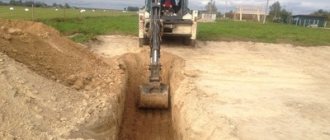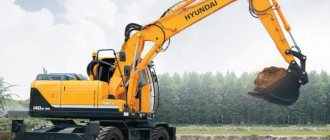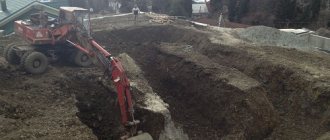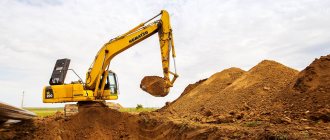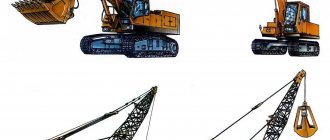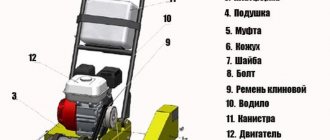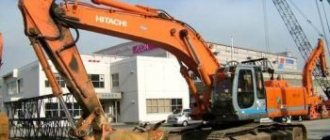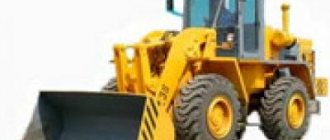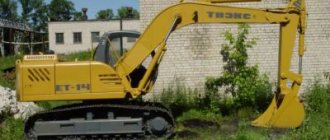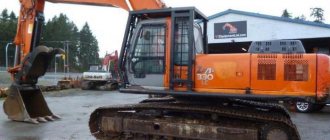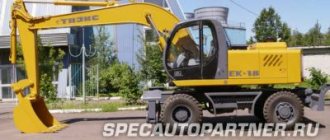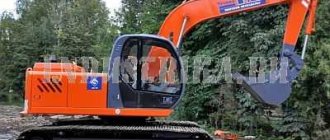Excavators are special machines that can quickly excavate large amounts of soil. Without them, the construction of facilities may take many years.
In the article we will consider all aspects of trench development and digging with an excavator. What types of equipment are used, process technology and what is the approximate cost of the work.
Features of machine development
It is difficult to imagine some construction projects without the development of trenches. Excavation work is classified as basic operations. Trenches are dug to deepen the foundations of buildings, which helps stabilize the situation.
Trenches differ from pits in that they are elongated in one direction. This, in other words, is simply an elongated channel in the ground. The width ranges from 50 cm to 5 meters. The depth can also be significant.
The exceptional efficiency of excavators is the main reason why they have become popular. It doesn’t matter whether a straight shovel or a backhoe is used, the speed of execution is higher compared to manual work. The productivity of high-quality equipment is 50-100 cubic meters of soil per hour.
When and why is digging with special equipment used?
Single-bucket equipment is suitable for all types of soils and rocks. Including high humidity and groundwater inflow. For soils from categories 1 to 4 inclusive, it is recommended to use multi-bucket types of equipment. Although safe operation is permissible only in categories 1 to 3. In the case of 4, manipulations should be carried out only in homogeneous layers.
In order to dig a trench,
a machine is selected after studying the important parameters:
- The need to use replaceable devices.
- Availability and possibility of groundwater inflow.
- Category of cut material.
- Notch characteristics.
If several models are suitable at once, it is recommended to give preference to forward and reverse shovels, or so-called “draglines”.
Maximum filling with minimum time is important to determine the volume for the bucket capacity. The maximum load indicator is directly dependent on the depth of work, the complexity of cutting, and the type of material being processed. Climatic conditions and terrain also influence the final decision.
Digging trenches manually
In most cases, all trenches are dug below the freezing depth of the soil. Almost always, this depth is about a meter. Therefore, for example, we will consider this particular depth - 1 meter.
One worker in an hour of working time can dig from one to three meters of a trench, depending on the type of soil. Let's take the average. Let's say that one person can dig 2 meters in one hour. For a full working day, which lasts 8 hours, one worker will be able to dig about 16 meters. And such an employee will have to pay about 2,000 rubles. From these calculations we can conclude that the cost of digging one meter by hand is 125 rubles.
Types of cars
The simplest single-bucket excavator is a technique designed for various excavation work and manipulations in the construction industry.
There are not many stages in the production cycle of equipment:
- First, the soil layer is cut and the bucket part is filled.
- The filled bucket is raised to move unhindered to the dumping site.
- The boom is raised to the unloading area. Sometimes lifting the bucket is performed simultaneously with this operation.
- The cut rock is poured out.
- The bucket part is fed again to repeat the loading.
Running equipment ensures the advancement of equipment. itself is divided into several types:
- Rail-walking. With reduced surface pressure and increased maneuverability.
- Walking. It is stable and the pressure on the surface is also minimal.
- Pneumatic.
- Crawler. Provides increased cross-country ability. Suitable for working with difficult terrain.
From the entire production cycle, up to 15-30% of the working time is spent on cutting the rock and collecting it. Therefore, multi-bucket types are considered more productive. Several buckets of different widths ensure continuity of the work process. But there are restrictions related to the dimensions of the rock being lifted. Single-bucket technology works without such restrictions.
There are also rotary and chain excavators:
- Rotary are units with strictly parallel digging. The rotor itself rotates parallel to the axis of the trench.
- Chain varieties are also named after the main working element with which the equipment is supplied. Usually the main body is the frame on which additional equipment is hung.
Over time, mini excavators appeared. Nowadays this technique can be found almost everywhere due to its versatility. The devices cope with different fillings weighing up to 1 ton.
A mini-excavator is usually called a smaller version of standard equipment. An excellent option for small volumes of work and cramped conditions.
Another type of equipment is front loaders. Details of how this type of equipment works in the video:
Separate parts of the excavator operating cycle
To excavate, it is important to perform the following individual operations:
- cutting the soil with a bucket;
- rotation of the excavator platform;
- unloading soil from a bucket;
- reverse rotation to the surface being developed;
- setting the bucket to repeat the entire cycle.
As far as you can see, digging the soil itself takes quite a bit of time. More than 50% of the cycle is spent turning the excavator platform. To save time and fuel, it is recommended to perform several actions at the same time.
For example, the rotation of the platform and the detachable bucket for deepening can be performed in parallel. Moreover, placing the bucket on the ground is a separate issue. The point is that the boom should be extended by 70% (according to the technical regulations from the manufacturers of excavator equipment).
The ideal depth of the bucket is 100%. To save time on transporting soil, it is better to dump the bucket into the back of a truck. Moreover, carrying the bucket over the dump truck cab is strictly prohibited!
Technology and rules for developing soil using special equipment
This type of work can be observed at almost all industrial and residential construction sites.
The standard diagram looks like this:
- Geological examination, site analysis.
- Development of project documentation.
- Selection of special equipment with the right characteristics.
- Organizational and preparatory activities.
- Soil development. The layers are removed sequentially.
- Strengthening and processing of pit walls.
- Acceptance of work from the customer.
Surveyors are specialists who monitor the implementation of the project at each stage. Separately monitor safety rules and their compliance. Based on engineering surveys, design documentation is drawn up, which is then based on when performing work.
Typical technological maps
The regulatory framework is built on the following acts:
- SNiP-3-42-80.
- SNiP_12-03-2001.
- SNiP_3.05.04-85.
- SNiP_3.02.01-87.
- SNiP_12-01-2004.
According to the technology, first a permit is issued in Gati. Then they move on to organizational and preparatory work. At this stage, responsible persons are identified and information boards are installed. Separately, they accept the breakdown base and receive a working draft with a pipeline plan.
Other issues need to be taken care of:
- Obtaining a technological map.
- Conducting training for workers.
- Creation of access roads.
- Installation of inventory structures in accordance with the construction master plan.
Then they move on to preparing tools and equipment. Workers are provided with everything necessary, including personal protective equipment. Only after completion of the previous stages is a report stating that the object is ready for further work.
Description of construction work
Development of a ditch involves the following stages of construction work:
- Excavation of soil, after which it is thrown into a dump. This is done until the depth of the trench corresponds to the previously created project.
- In areas with pipe joints, pits are dug.
- If required, slopes and drainage systems are installed.
Scheme of developing a trench with an excavator:
A geodetic breakdown of the area is carried out in horizontal and vertical planes. The requirements for this work are described by SNiP 3.02.01-87. Before digging a ditch, take special care of cleaning the area . It is important to remove all debris and traces of old building materials.
The bulldozer leveling will provide a surface slope consistent with the original design. The soil mass and unevenness can be eliminated at a height of up to 15 cm.
Development of soil using a machine
The project determines which scheme is used in the initial organization of work. For example, the technological map assumes the use of a backhoe. In this case, the cutting takes place on itself, with digging below the parking level. On one side of the trench, dumps are arranged, their distance from the edge is at least 50 cm.
The waste soil is removed; if necessary, it can be reused for one of the following purposes:
- Filling an unclaimed trench.
- Sinus filling.
- Organization of reserve dumps.
Due to the shortage, they ensure the preservation of high soil strength. Filling the excavation with identical local soil will compensate for the excess material. It is enough to add the composition to the mark according to the design. 0.95 is the optimal coefficient for compaction.
Common types of foundation walls
The choice of foundation walls depends on the load-bearing capacity, freezing depth and degree of soil mobility. In addition, the type and total weight of the building, predicted static and dynamic loads, and the presence of a basement or ground floor in the project are taken into account.
When constructing small buildings and private houses, 4 types of reinforced concrete foundations are usually used:
- Pile
. Does not require deep penetration of reinforced concrete walls. - Columnar
. It is used for the construction of wooden and prefabricated houses without a reinforced concrete foundation slab. Does not require digging a trench or foundation pit. - Tape
. The best solution in cases where the soil does not hold its shape well. The trench for the strip foundation is made trapezoidal, which increases the stability of the monolithic structure. - Slab
. Ideal for building houses up to three floors high. It is a one-piece monolithic structure that is practically not subject to subsidence and is not afraid of soil displacement.
Advice
: Whatever wall you choose for your foundation, make a cushion of sand and gravel mixture (SGM) under the base. Coarse crushed stone will ensure soil drainage, and sand will ensure uniform shrinkage of the structure.
If you still have questions about digging a trench or foundation pit, call +7 495 775 33 33 to get qualified answers or to order.
What is the price for equipment services?
There are several factors that influence the price of soil development using this equipment:
- Distance between workplace and base.
- The topography of the soil along with its condition.
- Soil characteristics.
- Total scope of work.
The TSN price estimate base is the main document that also determines the cost . The soil group and bucket capacity must be taken into account when determining the results. The larger the bucket size, the larger the size of the equipment itself.
An example of the cost of developing a trench per meter:
| Name of works | Unit | price |
| Compacted crushed stone base manually layer by layer more than 300 mm | M2 | 2200 |
| Compacted crushed stone base by hand up to 300 mm | M2 | 200 |
| Compacted sand base from 300 mm | M2 | 600 |
| Compacted sand base up to 300 mm | M2 | 600 |
| backfilling | M3 | 200 |
| Manual soil development | M3 | 300 |
| Mechanized method | M3 | 300 |
| Site breakdown, coordinates removal | DOT | 400 |
Pros and cons of using machines in soil development
Productivity automatically increases when using any type of excavator.
The equipment guarantees safe and stable operation , which is important for statistics throughout the industry.
Modern technology has practically no disadvantages. You just need to monitor their updates and technical characteristics.
Costs may increase in the early stages, but the benefits from further operation are much greater and can fully cover any costs.
How to properly dig a pit with an excavator?
An excavator is very often used for excavation work.
Let us remember that there is a wide range of similar equipment. Many specialized companies can provide very miniature models that can be used even on a small plot of land. At the same time, mechanization makes it possible to achieve incredibly high productivity in creating trenches and digging pits. In fact, there is nothing complicated about digging a pit; you just need to follow the technical rules. Of course, it is categorically not recommended to start the process until a full-fledged excavation plan has been developed. In addition, before starting to dig a pit, it is important to assess the qualitative composition of the soil. On the website https://strent.com.ua/razrabotka-kotlovanov you can get professional help regarding excavation work. But professionals do not always agree to participate in the project (an example is an object extremely remote from the city). In this case, you will have to rely only on your own strength and the recommendations listed below.
